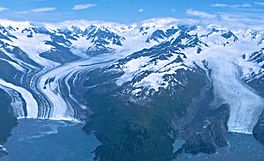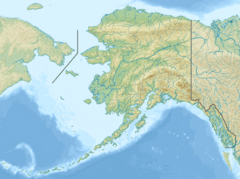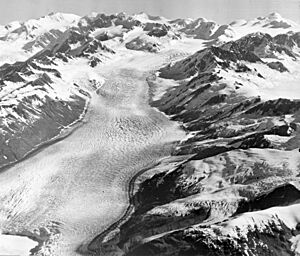Yale Glacier facts for kids
Quick facts for kids Yale Glacier |
|
|---|---|

Yale Glacier on right. (Harvard to left)
|
|
| Type | Tidewater glacier |
| Coordinates | 61°17′16″N 147°28′40″W / 61.28778°N 147.47778°W |
| Length | 20 miles (32 km) |
| Terminus | Sealevel |
| Status | Retreating |
The Yale Glacier is a large glacier in Alaska, a state in the U.S.. It is about 20 miles (32 km) long. This glacier starts high up between two mountains, Mount Witherspoon and Mount Einstein. From there, it flows southwest into a part of College Fjord called Yale Arm. This area is about 47 miles (76 km) west of the city of Valdez.
Explorers from the 1899 Harriman Alaska expedition named the glacier after Yale University.
Contents
What is Yale Glacier Like?
Yale Glacier is quite wide, measuring between 1.25 miles and 2 miles across. As it moves down, the glacier slopes quite steeply. It reaches a height of 2,500 feet just a few miles from its end. It then goes up to 6,000 or 7,000 feet in the bowl-shaped areas (called cirques) near Mt. Glenn.
The glacier ends in the Yale Arm of College Fjord. Its front edge, where it meets the water, is very uneven. One side of the glacier sticks out further into the fjord than the other. This icy cliff at the end is very tall, between 200 and 300 feet high!
How the Glacier Moves
Glaciers are like very slow-moving rivers of ice. As they move, they pick up rocks and dirt. These materials form ridges along the sides of the glacier, called lateral moraines. Yale Glacier has clear lateral moraines. Unlike some other glaciers, Yale Glacier does not have many large smaller glaciers feeding into it. This makes it different from its neighbor, the Harvard Glacier.
How Yale Glacier Changes Over Time
Scientists and explorers have been watching Yale Glacier for many years. They have seen it change its size and position.
Early Explorers and Observations
In 1898, an explorer named Glenn described Yale and Harvard glaciers as "Twin Glaciers." He said they were an amazing sight, shining in the sun. He noted that huge pieces of ice were constantly breaking off the front of the glaciers and falling into the sea. This makes a loud roaring noise, especially because of the ocean tides. This process is called "calving."
In 1899, members of the Harriman Expedition took photos and described Yale Glacier. They showed that the glacier looked much like it did in 1910. They also noticed dirty ice near one side, suggesting there might be a rock hidden under the surface.
Recent Changes
Observations from 1905 and 1909 showed that Yale Glacier stayed mostly the same during those years. However, in 1910, the glacier was moving forward strongly. It was pushing over bushes and covering areas that used to be bare rock. This showed that the glacier was actively growing and moving forward at that time. Signs of this movement were seen in the autumn or early winter of that year.
Today, Yale Glacier is known to be retreating, meaning it is shrinking and moving back. This is a common trend for many glaciers around the world.



